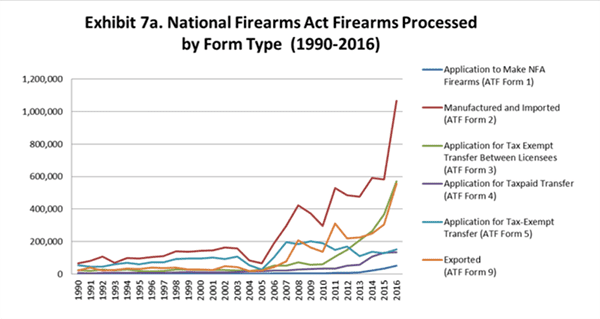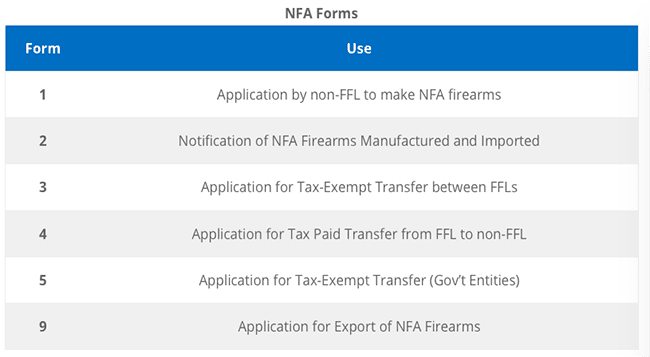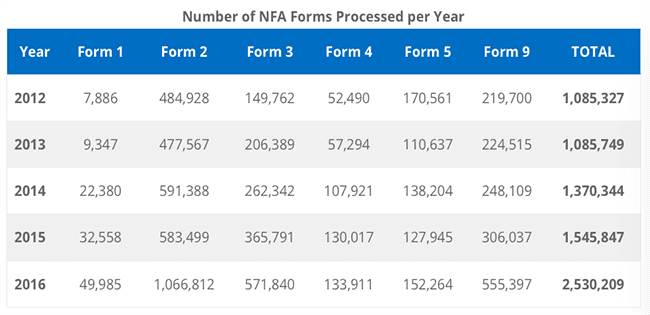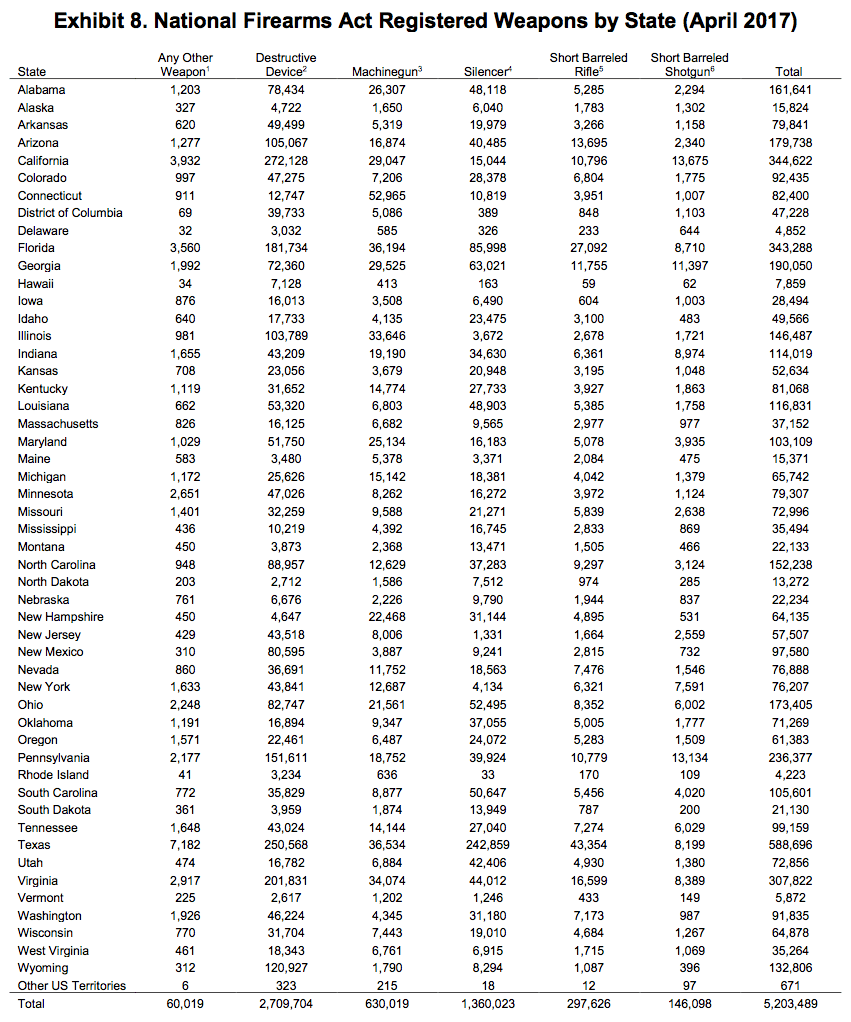
Welcome to the mother-lode of ATF-related data on NFA firearms. Each year the ATF publishes a report that includes data on the number of firearms in commerce (made, exported, and imported) and statistics on NFA firearms (forms, revenue, and distribution) and FFLs (applications and inspections).
In the ATF’s Firearms Commerce in the United States Annual Statistics Update 2017, they share information on:
– how many firearms were made in the United States
– how many firearms were exported
– how many firearms were imported
– the total number of import applications
– a break-down of country of origin for imported firearms
– National Firearms Act (NFA) taxes paid
– how many of each NFA form was processed
– NFA firearms registered by state,
– number of Special Occupational Taxpayers (SOTs) by state
– how many of each Federal Firearm License type are active
– a break-down of the number of FFLs by state
– a summary of FFL applications by year, and
– how many ATF compliance inspections occurred.
I told you that it was the mother-lode of data.
In this article, we’ll stick to the National Firearms Act (NFA) information to keep the information manageable. If you’re interested in the rest of the ATF data, check out our articles on Firearms in Commerce and FFL Applications and Inspections Statistics.
National Firearms Act (NFA) Forms Processed by ATF
It is no secret that sales of NFA firearms (silencers, short-barreled rifles, short-barreled shotguns, and more) have skyrocketed in recent years.
The market is so big for NFA firearms that many people recognize the business opportunity and want to get started making and/or selling NFA items. However, the process can be very intimidating for some. There’s a lot to know to get your FFL and become an SOT and there’s even more to know to stay out of trouble.
Because of this, we created RocketFFL to help you – check out our courses on Getting Your FFL and Becoming an SOT.
As you can see in the graph below, there’s a LOT more NFA firearm being manufactured than there are being sold/transferred (almost double). That’s what has led to some flooding of the market of NFA items.
The good news if you’re just starting out? Everything is on sale!
n 2016, the ATF processed 2,530,209 NFA forms. That’s not how many NFA firearms were sold – every firearm that was sold on a Form 4 to an individual was transferred from FFL to FFL on a Form 3 and manufactured by an FFL on a Form 2.
A better picture of the number of NFA firearms sold in 2016 is to look at the number of Form 4s processed by the ATF: 133,911.
That’s not much more NFA sales than the previous year even though manufacturing almost doubled.
You can see the numbers of each NFA Form back to 1990 in the ATF’s Report, but I’ve shared the last five years data from the ATF below.
If you haven’t taken training from us, you may not know what each Form is for and when it is used. Here’s a simple breakdown for you:


NFA Tax Revenue by Year
With record NFA sales comes record NFA tax revenue by the government.
Every Form 1 application to make an NFA firearm by an non-FFL and every Form 4 application to transfer an NFA firearm from an FFL to an individual requires the payment of a tax.
For most NFA firearms, the tax is $200. However, the tax for Any Other Weapons (AOW), the tax is only $5.
Also, an FFL can become a Special Occupational Taxpayer (SOT) to pay a tax once a year and avoid paying the tax per NFA firearm made or transferred. For some FFLs, this is a requirement. You can learn more about this in our Get Your FFL course.

In 2016, the ATF collected a total of $68,614,000 from NFA firearms activity! That’s $6,018,000 from SOTs and $62,596,000 from individuals paying transfer and making taxes.

Unfortunately, the ATF doesn’t get to keep that money to help pay for more people to process the forms and for a better infrastructure. Instead, the money goes into the general treasury.
When I managed federal government relations for the firearms industry’s trade association, the National Shooting Sports Foundation, we lobbied to have the money stay with ATF so that they could reduce the wait-times customers must wait after the purchase their NFA firearm and before they can lawfully possess it. Currently, those wait-times are up to 1 year!
This is another reason to get your FFL, you can get a silencer (or other NFA firearm) at discounted pricing within a month! Or, you can keep paying full-retail and waiting up to a year.
NFA Firearms by State
The ATF keeps an updated registry of the location of every NFA firearm on their National Firearms Registry and Transfer Record (NFR&TR).
Here’s a breakdown, by state, of the location and number of each type of NFA firearm (including Any Other Weapons, Destructive Devices, Machineguns, Silencers, Short-Barreled Rifles, and Short-Barreled Shotguns) in the United States:

This information helps us to know exactly (well, as precisely as the ATF can keep their records) how many registered NFA firearms are in our country…5,203,489.

If these stats are interesting to you and you’re not yet a part of the firearms industry, you might want to consider it.
You’ll stop having to worry about spending so much money on guns and you’ll start making money with them!
I look forward to having you in our industry.
This post was originally published at rocketffl.com and is reprinted here with permission.




TL;DR
That last table is very interesting, NY has a lot of registered NFA items for the civilian police force
Its a buyers market now. Given the high inventory and low sales, its the worst time to start a firearms sales business
Are the names and addressees of the individual NFA stamp holders legally considered confidential information?
If not, it damn sure need to be.
And it should be done while we have (somewhat) control of government…
Owning a NFA-registered item is like anything else. The names and addresses is registered with the Federal government, and accessible through any legal means necessary.
Freaking idiots, around here, most don’t file any forms. Granted, half are home made. Any ATF event in this area will end with multiple people shot.
Something doesn’t seem to add up….
~$62million in “making and transferring” monies paid to teh Govt in 2016….
Estimating at $200 a pop, that’s about 310,000 NFA firearms in 2016.
But there were only ~50,000 Form 1’s and only about 133,000 Form 4’s.
Nothing is paid for Form 2’s or Form 3’s or Form 5’s or Form 9’s……right?
So ~50,000 + 133,000 = ~183,000…..which is about 150,000 shy of number you’d conclude based on the taxes received as reported by the ATF???
Missing NFA stuff??
huh?
I knew Texas was gonna have a lot… but damn…
GREAT – data/info in the hands of big brother. What could go wrong.
I sure wish I could get my FFL…damn zoning or else i would have 5 years ago!
I’m actually most curious about the high number of DD’s. I have a Registered 60mm mortar but I am surprised that there are twice the number of DD’s as there are suppressors. Mostly 40mm grenade launchers maybe?
I find it really interesting that California is 2nd only to Texas for total NFA registered items in the US. Being in FL I dont know much about Cali gun laws, but I thought the majority of NFA things were just straight-up illegal to have, but this shows 15000 suppressors alone
Florida has more machine guns, silencers and short barreled
Rifles than any other state… except for Texas!
Come on Florida, let’s beat those Texans!
I’ve done my bit with my CZ Scorpion
The folding stock and silencer make it a 2 stamp ( both pending) gun
Comments are closed.